#no code mobile app builder
Explore tagged Tumblr posts
Text
App Store Optimization in 2024: A Comprehensive Guide for Play Store Success with No-Code App Builders
Introduction
As the mobile app market continues to expand, standing out in the crowded Google Play Store has become more challenging than ever. App Store Optimization (ASO) is crucial for ensuring your app ranks high in search results and attracts the right audience. In 2024, mastering ASO is essential for any app developer, including those using no-code app builders. This article provides a comprehensive guide to optimizing your Play Store listing, with a focus on how no-code app builder can streamline the process.
1. Understanding ASO in 2024
App Store Optimization (ASO) is the process of improving the visibility of your app in an app store's search results. The goal is to increase organic downloads by making your app more discoverable. In 2024, ASO strategies are evolving with the latest trends in user behavior, search algorithms, and mobile technology. Whether you're building your app with a no-code app builder or through traditional development, understanding these trends is key to staying competitive.
2. Keyword Research and Optimization
Keywords are the foundation of ASO. In 2024, keyword optimization continues to play a critical role in how apps are ranked in the Play Store. Start by researching the most relevant and high-traffic keywords for your app. No-code app builders often offer integrated tools that help identify these keywords, simplifying the process for non-technical users. Be sure to include your primary keywords in the app’s title, description, and metadata.
3. Optimizing Your App’s Title and Description
The title of your app is one of the most important factors in ASO. It should be concise, descriptive, and include your main keyword. In 2024, Google Play's search algorithm favors titles that clearly reflect the app's purpose and function. No-code app builders can assist in generating effective titles by suggesting relevant keywords based on the app's content.
Your app’s description is another critical component. The first few lines of the description are especially important, as they are often displayed in search results. Ensure that your description is clear, compelling, and keyword-rich. With no-code app builders, you can easily update and optimize your app’s description as you test different keywords and phrases to see what works best.
4. High-Quality Visual Assets
Visual appeal is crucial in attracting users. This includes your app icon, screenshots, and promotional videos. In 2024, users are more likely to engage with apps that have high-quality, visually appealing assets. No-code app builders make it easy to design and upload these assets, even for those without a background in graphic design. Use tools provided by your no-code platform to create professional-looking visuals that resonate with your target audience.
5. Leveraging User Reviews and Ratings
User reviews and ratings significantly impact your app’s ranking in the Play Store. Encourage satisfied users to leave positive reviews and address any negative feedback promptly. No-code app builders often include features that make it easy to integrate in-app prompts for reviews and ratings. By actively managing and responding to user feedback, you can improve your app’s reputation and ranking over time.
6. A/B Testing for Continuous Improvement
A/B testing involves comparing two versions of your app’s store listing to determine which one performs better. This could include testing different titles, descriptions, icons, or screenshots. In 2024, A/B testing remains a vital component of a successful ASO strategy. No-code app builders frequently offer built-in tools for A/B testing, allowing you to experiment with different elements of your listing without needing advanced technical skills.
7. Tracking and Analyzing Performance
Monitoring the performance of your ASO efforts is essential to ensure continued success. Use analytics tools to track your app’s rankings, downloads, and user engagement. No-code app builders often come with integrated analytics dashboards, making it easier to analyze your app’s performance and make data-driven decisions. Regularly reviewing these metrics will help you refine your ASO strategy and stay ahead of the competition.
8. Adapting to Play Store Algorithm Changes
Google frequently updates its Play Store algorithms, which can impact your app’s ranking. Staying informed about these changes is crucial for maintaining visibility. No-code app builders typically provide updates and resources to help users adapt to these changes, ensuring that your app remains optimized for the latest algorithm updates.
Conclusion
App Store Optimization is a critical component of your app’s success in the Play Store, and it’s more important than ever in 2024. By leveraging no-code app builders, you can simplify the ASO process, making it accessible even to those without technical expertise. From keyword research and visual asset creation to A/B testing and performance tracking, no-code platforms offer the tools you need to optimize your app’s Play Store listing effectively. Embrace these strategies to improve your app’s visibility, attract more users, and achieve sustained success in the competitive mobile app market.
2 notes
·
View notes
Text
How to Create a Mobile App Without Coding Skills: A Beginner's Guide

In today's tech-savvy world, having a mobile app for your business, hobby, or personal use has become increasingly popular. However, the misconception persists that developing an app requires advanced coding skills and technical expertise. Fortunately, thanks to advancements in technology, creating a mobile app builder has become more accessible to individuals without coding knowledge. In this beginner's guide, we'll explore the step-by-step process of creating a mobile app without writing a single line of code.
Understanding the Basics
Before diving into app development, it's essential to grasp the fundamentals. A mobile app is a software application designed to run on mobile devices such as smartphones and tablets. These apps can serve various purposes, from entertainment and productivity to e-commerce and social networking.
Why Create a Mobile App?
The benefits of having a mobile app are manifold. For businesses, it can enhance customer engagement, boost brand visibility, and generate additional revenue streams. For individuals, it provides a platform to showcase creativity, share knowledge, or simply solve everyday problems more efficiently.
Common Misconceptions
One of the most significant misconceptions about app development is that it requires extensive coding skills. While coding certainly plays a crucial role in traditional app development, there are now alternative methods that allow individuals to create apps without coding.
Choosing the Right Approach
When it comes to creating a mobile app without coding skills, there are several approaches you can take. Each approach has its own set of pros and cons, so it's essential to choose the one that best aligns with your goals and expertise.
App Builders and Platforms
App builders or app development platforms are online tools that provide a user-friendly interface for creating mobile apps without coding. These platforms typically offer drag-and-drop functionality, pre-designed templates, and built-in features that make app development accessible to beginners.
No-Code Development Platforms
No-code development platforms take app development a step further by eliminating the need for any programming knowledge whatsoever. These platforms typically use visual interfaces and pre-built components to enable users to create fully functional apps with minimal effort.
Planning Your App
Once you've chosen the approach that best suits your needs, it's time to plan your app. This involves defining its purpose, identifying its target audience, and outlining its features and functionalities.
Define Your App's Purpose
Before you start building your app, ask yourself: What problem does it solve? What value does it provide to users? Clearly defining your app's purpose will help guide its development and ensure that it meets the needs of your target audience.
Identify Your Target Audience
Understanding your target audience is key to creating a successful app. Consider factors such as demographics, interests, and pain points to tailor your app to the needs and preferences of your target users.
Outline Your App's Features
Make a list of the features and functionalities you want your app to have. Start with the essential features that are core to your app's purpose, then consider additional features that could enhance the user experience.
Designing Your App
The design of your app plays a crucial role in its success. A well-designed app not only looks good but also provides a seamless and intuitive user experience.
User Interface (UI) Design
The UI design encompasses the visual elements of your app, including layout, colors, typography, and graphics. Aim for a clean and intuitive design that makes it easy for users to navigate and interact with your app.
User Experience (UX) Design
UX design focuses on the overall experience of using your app, from the moment users open it to when they complete their desired actions. Pay attention to factors such as usability, accessibility, and performance to ensure a positive user experience.
Prototyping and Testing
Before finalizing your app design, create prototypes to visualize how it will look and function. Conduct usability testing with real users to gather feedback and identify any usability issues or areas for improvement.
Building Your App
Once you have a clear plan and design for your app, it's time to start building it using your chosen development platform.
Drag-and-Drop Interface
If you're using an app builder or no-code platform, take advantage of the drag-and-drop interface to add elements, customize layouts, and configure functionalities. Experiment with different features and settings to achieve the desired look and functionality for your app.
Customization Options
Most app development platforms offer a range of customization options, allowing you to personalize your app to reflect your brand identity and style. Take the time to explore these options and make your app stand out from the crowd.
Integration with Third-Party Services
Many app development platforms allow you to integrate your app with third-party services and APIs to add additional functionalities. Explore the available integrations and consider how they can enhance your app's features and capabilities.
Testing and Launching Your App
Before releasing your app to the public, it's essential to thoroughly test it to ensure it functions correctly and meets the needs of your users.
Beta Testing
Invite a small group of beta testers to try out your app and provide feedback. Look for any bugs, glitches, or usability issues that need to be addressed before the official launch.
App Store Submission
Once you're confident that your app is ready for release, submit it to the appropriate app stores (e.g., Apple App Store, Google Play Store). Follow the submission guidelines and requirements to ensure a smooth approval process.
Marketing and Promotion
Launching your app is just the beginning. To attract users and drive downloads, invest in marketing and promotion efforts such as social media campaigns, app store optimization (ASO), and influencer partnerships.
Conclusion
Creating a shopify mobile app builder without coding skills may seem daunting at first, but with the right tools, resources, and guidance, it's entirely achievable. Whether you're a business owner looking to expand your reach or an individual with a creative idea, the opportunities for app development are endless. By following the steps outlined in this beginner's guide, you can turn your app idea into reality and bring your vision to life. So what are you waiting for? Start building your dream app today!
#best no code mobile app builder#white label mobile app builder#no code mobile app builder#mobile app builder#best mobile app builder#shopify mobile app builder#ecommerce mobile app builder#online store app builder#shopify mobile app template#integrate shopify with android app#mobile app builder for shopify#best shopify mobile app builder
1 note
·
View note
Text
7 Reasons Why Professionals Should Choose a No-Code Mobile App Builder

In today's fast-paced digital landscape, professionals across various industries are increasingly turning to no-code mobile app builders as their go-to solution for app development. These platforms empower users with limited or no programming experience to create robust mobile applications swiftly and efficiently. Discover the best no-code mobile app builder! Learn why professionals are choosing this innovative tool for seamless app development. This article explores the key reasons why professionals should consider adopting no-code app builders for their next mobile app project.
Accessibility and Ease of Use
No-code mobile app builders democratize app development by eliminating the need for extensive coding knowledge. They offer intuitive drag-and-drop interfaces and pre-built templates that allow professionals from diverse backgrounds to create fully functional apps with minimal learning curve.
Rapid Prototyping and Time Efficiency
Professionals often face tight deadlines and the need for quick iterations. No-code app builders enable rapid prototyping, allowing users to visualize and test app ideas swiftly. This agility in development accelerates time-to-market, giving professionals a competitive edge in their respective industries.
Cost-Effectiveness and Budget Control
Traditional app development can be prohibitively expensive, requiring hiring developers and investing in infrastructure. No-code platforms significantly reduce costs by eliminating the need for a dedicated development team. Professionals can allocate resources more efficiently, focusing on app functionality and user experience rather than backend complexities.
Flexibility and Customization Options
Despite being no-code, modern app builders offer extensive customization capabilities. Professionals can tailor apps to specific business needs, incorporating unique branding elements and functionalities. Advanced features such as API integrations and data analytics ensure that apps remain robust and scalable as business requirements evolve.
Empowerment of Non-Technical Teams
No-code app builders empower professionals across departments, not just IT specialists. Marketing teams can create promotional apps, sales teams can develop customer engagement tools, and HR departments can streamline internal processes—all without relying on technical resources. This democratization of app development fosters innovation and collaboration within organizations.
Seamless Integration with Existing Systems
Integrating new apps with existing IT infrastructure can be a daunting task. No-code platforms simplify this process through plug-and-play functionalities and seamless integrations with popular business software and cloud services. Professionals can leverage existing data and workflows, ensuring compatibility and continuity across platforms.
Scalability and Future-Proofing
As businesses grow, so do their app requirements. No-code app builders offer scalability without the overhead of rewriting code or rebuilding applications from scratch. Professionals can easily update and expand app functionalities as their user base expands or new business opportunities arise, future-proofing their digital investments.
Conclusion
The adoption of no-code mobile app builders represents a paradigm shift in how professionals approach app development. These platforms empower individuals and organizations to innovate rapidly, reduce costs, and maintain flexibility in an increasingly digital world. By leveraging the accessibility, speed, and cost-effectiveness of no-code solutions, professionals can drive business growth, enhance productivity, and stay ahead of the competition. Discover the best no-code Shopify mobile app builder for professionals! Explore 7 compelling reasons why you should choose this hassle-free solution to create powerful mobile apps. Start building today! Whether you're a startup entrepreneur, a small business owner, or a corporate executive, embracing no-code app development can unlock new opportunities and propel your digital initiatives to new heights.
#best no-code mobile app builder#drag and drop mobile app builder#white label mobile app builder#no-code mobile app builder#mobile app builder#best mobile app builder
2 notes
·
View notes
Text

No-Code App Development & Its Game-Changing Benefits
Explore a no-code app builder with AI for seamless mobile app development. Reach out to us for more details on the best mobile app maker.
#no-code app builder#AI no-code app builder#no-code app builder with AI#mobile app builder#custom app development
0 notes
Text
The Best AI No-Code App Builders to Create Mobile Apps 2025
Forget everything you know about learning to code to build an app because all you need nowadays are no-code app builders. These powerful tools allow anyone to create fully functioning mobile apps that can be published on both the Android and iOS app stores—without writing a single line of code. This means you no longer need a technical background or the budget to hire expensive developers to…
0 notes
Text
5 Best Mobile app development tools to consider
1. Appery.io
Appery is an entirely cloud-based platform for creating mobile apps. As a result, developers don’t have to download anything to their systems. The drag and drop interface are the finest feature since it makes development simple for beginners.
2. BiznessApps
Bizness apps is an innovative mobile app development platform that offers a mostly automated way to create applications while also facilitating the creation of apps that simplify social engagement.
3. Mobile Roadie
Although it’s arguably one of the more expensive tools for creating mobile apps, this one offers an astounding degree of flexibility. This is a fantastic tool for companies who want to develop and manage applications that promote engagement.
4. Appypie
Appypie is a tool that allows you to create a mobile app without knowing how to code. It enables you to easily integrate social media. App analytics are offered by this tool to enhance user experience.
5. jQuery Mobile
This tool allows developers to simultaneously construct mobile-friendly webpages and mobile applications using the same data and procedures. The theme roller may be used to make sure that the app is flawlessly branded before it is released to users.
Transform your vision into reality with Tecnolynx Mobile App development services – Empowering Innovation, Building Futures in Mobile App Development!
#Appery#Cloud-based app development#Mobile app development platform#No-code app development#Appery.io features#Rapid app development#Cross-platform app development#Appery.io benefits#App builder#Web and mobile applications
0 notes
Text
Fulfilling The Students Social & Learning Aspirations
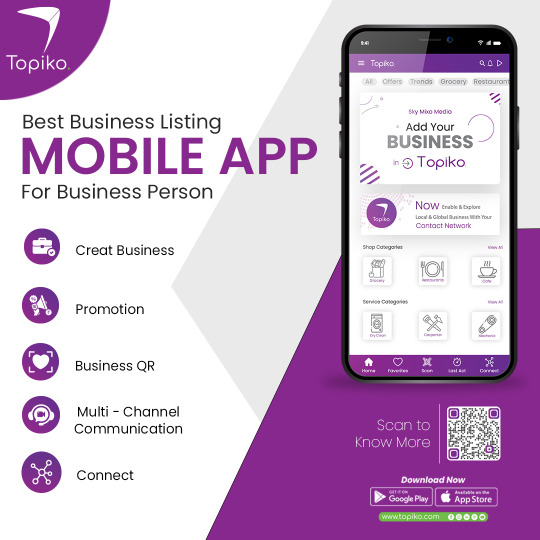
Topiko can be your buddy-on-hand to brush-up your skills and learning endeavors. It’s flexible and adapts to your learning needs, whether you’re a high-school student, undergraduate or a postgraduate, you’ll absolutely love to use it on your phone.
Other than learning, students can set up user accounts for socializing, look-ups for promotional offers and best buy deals offered by businesses listed in the app Online Store Builder.
Unlike student apps that are exclusively dedicated towards online learning, Topiko lets you play around if you’ve been pursuing a hard study schedule Digital Store Creator.
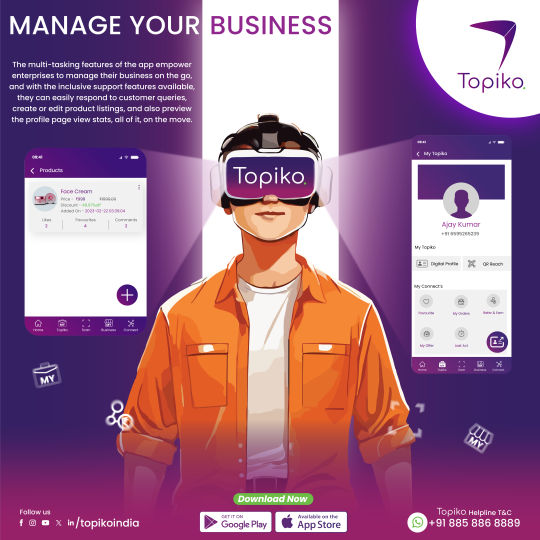
Look-up for denim jeans or other apparel offered by listed neighborhood stores, or kill your hunger walking into a restaurant nearby, find the best pizza deals, all with a click of a button.
The flexibility of having Topiko’s multi-communication tools on your cell phone provides you mobility; it doesn’t pin you down or confine you to your home Mobile business networking. You can learn on the go, while traveling in a local bus or public transport.
Just like other social apps, Topiko too lets you set up a profile page, highlighting your skills or bio. If you are planning to start a small enterprise, or develop your career, go ahead and set up a business account on Topiko.
Add all information and material to your profile page, including images and videos highlighting the area of your specialty, whether you are a budding actor, musician or a craftsman selling exquisite products, Topiko will set you up for an illustrious and promising journey online, in a competitive work space on the web.
The simple and user-friendly interface lets you earn while you learn, using the many features of the app, you can use it as a spring-board to leap into an exciting and engaging career ahead Online Store Builder.

The highly interactive features of Topiko lets you create and manage your student profile the way you want it, making it engaging and effective, while transforming your learning experience exciting and fun.
So go ahead and download Topiko from the Google or Apple play store, and access all information and study material on your fingertips Digital Store Creator.
To know more about our business please click here: https://topiko.com/
Facebook: https://www.facebook.com/people/Topikoindia/100093119861911/
Instagram: https://www.instagram.com/topikohyd/
DownloadTopiko: https://play.google.com/store/apps/details?id=com.vab.topiko&hl=en&gl=US
https://apps.apple.com/in/app/topiko/id161407221
Youtube: https://youtu.be/V22nnVXI6jI
#Digital Store Builder#Online Store Builder#Mobile business networking#Mobile networking app#Business networking#B2B networking#Small business tools#Small business website#Web design solutions#Online business software#Total business solutions#Networking platform#Mobile business card app#Smartphone business cards#Online professional profile#QR code business cards#Connect on social networks#Youtube
1 note
·
View note
Text
Twine/SugarCube ressources
Some/most of you must know that Arcadie: Second-Born was coded in ChoiceScript before I converted it to Twine for self-publishing (for various reasons).
I have switched to Ren'Py for Cold Lands, but I thought I would share the resources that helped me when I was working with Twine. This is basically an organized dump of nearly all the bookmarks I collected. Hope this is helpful!
Guides
Creating Interactive Fiction: A Guide to Using Twine by Aidan Doyle
A Total Beginner’s Guide to Twine
Introduction to Twine By Conor Walsh (covers Harlowe and not SugarCube)
Twine Grimoire I
Twine Grimoire II
Twine and CSS
Documentation
SugarCube v2 Documentation
Custom Macros
Chapel's Custom Macro Collection, particularly Fairmath function to emulate CS operations if converting your CS game to Twine
Cycy's custom macros
Clickable Images with HTML Maps
Character pages
Character Profile Card Tutorial
Twine 2 / SugarCube 2 Sample Code by HiEv
Templates
Some may be outdated following Twine/SugarCube updates
Twine/Sugarcube 2 Template
Twine SugarCube template
Twine Template II
Twine Template by Vahnya
Sample Code and more resources
A post from 2 years ago where I share sample code
TwineLab
nyehilism Twine masterpost
How to have greyed out choices
idrellegames's tutorials
Interactive Fiction Design, Coding in Twine & Other IF Resources by idrellegames (idrellegames has shared many tutorials and tips for Twine, browse their #twine tag)
How to print variables inside links
How do I create a passage link via clicking on a picture
App Builder
Convert your Twine game into a Windows and macOS executable (free)
Convert your Twine game into a mobile app for Android and iPhone (90$ one-time fee if memory serves me right) // Warning: the Android app it creates is outdated for Google Play, you'll need to update the source code yourself
233 notes
·
View notes
Text
Just wanted to let some people about this AAC app I found recently called "Weave chat AAC". It's free with no ads
Things about it:
-Option to read instructions outloud
-Voice pitch and speed is a slider
-You can add your mobile phone number and message people using the app
-Lots of topics to choose from that aren't usually included in AAC, such as politics, gender identity, and genitals
-Along the same topic, there is self advocacy buttons (such as "don't read my messages before I've said them" or "stop guessing")
-Phrase builder and word adder
-Ability to type
-Word finder
-Ability to adjust text and image size
-Better options for grammar
Others things to note:
-There is a mandatory sign up, which includes getting a code from your phone or email
-It could just be my device, but it seems laggy
-Despite the inclusion of words about "private parts", I feel like there could be more. They had penis, vagina, and breasts, which is a lot more than most AAC apps, but I feel there could be more
-I'm unsure of which, but some words are apparently age restricted
-I'm unfortunately unsure if it's compatible with tablets
-Personal issue, but the old AAC app I used had a button that would get people's attention (when pressed, it would vibrate and activate your phone flashlight a threes time for three seconds) which is something I feel should be more common place
Thats my review
#aac device#aac app#actually autistic#Hebephrenia#nonverbal#semiverbal#communication difficulties#communication disorders
20 notes
·
View notes
Text
Website Development Trends to Watch in 2025 🌐🚀

As technology evolves, so do website development trends. In 2025, businesses must adapt to faster, smarter, and more user-friendly web experiences.
Here are the top trends shaping web development in 2025—and how they impact businesses and developers.
🚀 Top Web Development Trends in 2025
1️⃣ AI-Powered Web Development 🤖
AI and machine learning are revolutionizing how websites are built. Expect: ✔ AI-driven design tools for faster site creation ✔ Automated customer support with chatbots ✔ Personalized user experiences powered by AI
💡 Example: AI tools like Wix ADI can now design entire websites based on user preferences!
2️⃣ Web 3.0 & Decentralized Websites 🌐
The rise of blockchain and decentralized networks is changing web infrastructure. Key developments include: ✔ Decentralized hosting for greater security ✔ Blockchain integration for identity verification ✔ Smart contracts for seamless transactions
3️⃣ Progressive Web Apps (PWAs) 📱
PWAs are bridging the gap between websites and mobile apps, offering: ✔ Fast loading speeds & offline capabilities ✔ App-like experience on browsers ✔ Lower development costs compared to native apps
💡 Big brands like Twitter and Starbucks use PWAs for improved user engagement!
4️⃣ Voice Search & Conversational UI 🎙️
As voice assistants grow, websites must optimize for voice search SEO. Expect: ✔ Conversational keywords & structured data ✔ Voice-enabled navigation for hands-free browsing ✔ AI-powered chatbots for instant responses
5️⃣ Dark Mode & Adaptive UI 🎨
More websites will offer dark mode options to: ✔ Reduce eye strain & improve accessibility ✔ Save battery life on mobile devices ✔ Offer a sleek, modern design
6️⃣ No-Code & Low-Code Development ⚡
More businesses are embracing drag-and-drop builders for faster development. Key platforms: ✔ Webflow, Bubble, and Wix for no-code ✔ Low-code solutions for faster backend integrations ✔ Faster website launches without deep coding skills
📉 What’s Fading in 2025?
🚫 Overcomplicated UI/UX – Simplicity and clarity are winning. 🚫 Static Websites – Interactive and AI-driven content dominates. 🚫 Traditional SEO Strategies – Voice and AI-powered search optimization take over.
Final Thoughts: Stay Ahead in 2025
The future of website development revolves around AI, speed, security, and user experience. Businesses that embrace these trends will stay competitive and enhance customer engagement.
🌟 Which trend are you most excited about? Let us know in the comments!
#seo#social media marketing#digital marketing company#digital marketing services#seo services#digital marketing#emailmarketing#ppc
2 notes
·
View notes
Text
Benefits Of Conversational AI & How It Works With Examples

What Is Conversational AI?
Conversational AI mimics human speech. It’s made possible by Google’s foundation models, which underlie new generative AI capabilities, and NLP, which helps computers understand and interpret human language.
How Conversational AI works
Natural language processing (NLP), foundation models, and machine learning (ML) are all used in conversational AI.
Large volumes of speech and text data are used to train conversational AI systems. The machine is trained to comprehend and analyze human language using this data. The machine then engages in normal human interaction using this information. Over time, it improves the quality of its responses by continuously learning from its interactions.
Conversational AI For Customer Service
With IBM Watsonx Assistant, a next-generation conversational AI solution, anyone in your company can easily create generative AI assistants that provide customers with frictionless self-service experiences across all devices and channels, increase employee productivity, and expand your company.
User-friendly: Easy-to-use UI including pre-made themes and a drag-and-drop chat builder.
Out-of-the-box: Unconventional To better comprehend the context of each natural language communication, use large language models, large speech models, intelligent context gathering, and natural language processing and understanding (NLP, NLU).
Retrieval-augmented generation (RAG): It based on your company’s knowledge base, provides conversational responses that are correct, relevant, and current at all times.
Use cases
Watsonx Assistant may be easily set up to accommodate your department’s unique requirements.
Customer service
Strong client support With quick and precise responses, chatbots boost sales while saving contact center funds.
Human resources
All of your employees may save time and have a better work experience with HR automation. Questions can be answered by staff members at any time.
Marketing
With quick, individualized customer service, powerful AI chatbot marketing software lets you increase lead generation and enhance client experiences.
Features
Examine ways to increase production, enhance customer communications, and increase your bottom line.
Artificial Intelligence
Strong Watsonx Large Language Models (LLMs) that are tailored for specific commercial applications.
The Visual Builder
Building generative AI assistants using to user-friendly interface doesn’t require any coding knowledge.
Integrations
Pre-established links with a large number of channels, third-party apps, and corporate systems.
Security
Additional protection to prevent hackers and improper use of consumer information.
Analytics
Comprehensive reports and a strong analytics dashboard to monitor the effectiveness of conversations.
Self-service accessibility
For a consistent client experience, intelligent virtual assistants offer self-service responses and activities during off-peak hours.
Benfits of Conversational AI
Automation may save expenses while boosting output and operational effectiveness.
Conversational AI, for instance, may minimize human error and expenses by automating operations that are presently completed by people. Increase client happiness and engagement by providing a better customer experience.
Conversational AI, for instance, may offer a more engaging and customized experience by remembering client preferences and assisting consumers around-the-clock when human agents are not present.
Conversational AI Examples
Here are some instances of conversational AI technology in action:
Virtual agents that employ generative AI to support voice or text conversations are known as generative AI agents.
Chatbots are frequently utilized in customer care applications to respond to inquiries and offer assistance.
Virtual assistants are frequently voice-activated and compatible with smart speakers and mobile devices.
Software that converts text to speech is used to produce spoken instructions or audiobooks.
Software for speech recognition is used to transcribe phone conversations, lectures, subtitles, and more.
Applications Of Conversational AI
Customer service: Virtual assistants and chatbots may solve problems, respond to frequently asked questions, and offer product details.
E-commerce: Chatbots driven by AI can help customers make judgments about what to buy and propose products.
Healthcare: Virtual health assistants are able to make appointments, check patient health, and offer medical advice.
Education: AI-powered tutors may respond to student inquiries and offer individualized learning experiences.
In summary
The way to communicate with robots might be completely changed by the formidable technology known as conversational AI. Also can use its potential to produce more effective, interesting, and customized experiences if it comprehend its essential elements, advantages, and uses.
Read more on Govindhech.com
#ConversationalAI#AI#NLP#machinelearning#generativeAI#LLM#AIchatbot#News#Technews#Technology#Technologynews#Technologytrends#Govindhtech
3 notes
·
View notes
Text
10 Innovative Branding Ideas For Shopify Store
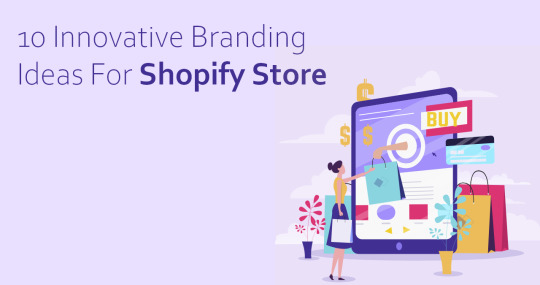
Shopify is among the most widely-used and biggest eCommerce platforms. Shopify's success is undeniable, and a large portion of its success comes from its user-friendly interface, cost-effective costs, and expert customer service. Shopify is incredibly successful in the current market, but Shopify store proprietors need to do much more than establish an online store. We've created this comprehensive guide to help you navigate Shopify's branding strategy. We'll cover the best strategies, provide real-world examples, and offer helpful tips to help you implement them. Now, let's get started:
What is Shopify Branding?
Consider the Shopify brand as the distinctive look your store is wearing online. It's all that makes your store recognized and shows your style. It's the visuals you use, like your logo, fonts, colors, and images, along with the overall tone and tone that you employ in your marketing and descriptions. It's not only about appearance but also about establishing trust and a connection with your customers.
Best Shopify Store Branding Ideas
One method to stay ahead of your competition in the competitive eCommerce market is to brand the shop Shopify store.
But making your own brand from scratch is not easy, and you'll need to learn how to do it. Naturally, many thoughts will arise when you consider developing the brand name in the Shopify business.
This comprehensive guide will explain the importance of branding your Shopify company and provide useful strategies for creating a strong image for your shop. You can use any of these suggestions to establish an identity for your Shopify store, no matter how long you've been operating in the business.
Have a User-friendly App For Your Store
Studies have shown that many customers choose to do business with companies that provide an individual experience. The best way to achieve this is through a user-friendly app.
With a seamless shopping experience accompanied by appealing visuals and information, it is easy to draw increasing numbers of customers. Furthermore, users appreciate apps more than online shopping.
However, small and medium-sized enterprises typically don't have the funds to build a custom app to run their business. Therefore, they choose to use Shopify mobile app builder, because it saves time, resources, and money while also allowing Shopify proprietors to get their products on the market first.
So, developing an application for your Shopify store can enhance the efficiency of your store online and provide your company with an edge in the market. In addition, developers can find applications in Shopify's Shopify application store to expand their business further.
Build Customer Profiles
Customer Personas are required to ensure that Shopify branding strategies are implemented with a clear understanding of the audience you are targeting. The lives of people within your target group constitute a customer profile. In other words, it's an essay that describes the who, what, and why of your prospective customers.
Harness the Power of Social Media
Social media platforms have turned into essential tools for businesses operating online to establish connections with their customers and increase the recognition of their brands. Below are some valuable suggestions on how to make the most out of social media
Find the right platforms: Then determine which social media platforms are the most popular among your targeted audience and focus your efforts on those channels. Websites such as Instagram and TikTok, for example, are ideal if the majority of your followers are young and visually inclined.
Interact with members of your community: Engage in conversation with your fans frequently by responding to messages, comments, and mentions.
Distribute valuable content: Provide your readers with things that are visually attractive, informative, and entertaining. You can consider including various types of content, such as informative guides, captivating product videos, authentic customer testimonials, behind-the-scenes photos, and insightful essays on relevant industries.
When used strategically, social media platforms provide a myriad of possibilities to reach a larger public and engage with your targeted audience.
Use Product Reviews
Shopify offers a variety of loyalty programs that permit you to collect and display product reviews on your site. In addition, you can request your customers to rate your product by sending them emails.
Collaboration with Other Brands
It's not necessary to think of other Shopify businesses as rivals. You may join forces and form partnerships with brands to reach a broader customer base and increase sales.
Find a company that works perfectly with yours, and work together on a campaign or giveaway.
Let's look at the scenario in which you sell sporting apparel. You could ally strategically to develop an offer with another fitness/wellness-related brand, like a seller of yoga mats or a supplement business.
Each business will be marketing to the same market that you share. A win-win scenario exists.
Go Offline
While it is highly effective, it isn't the only option. A traditional campaign that performs effectively can generate tons of dollars. Trade shows and other gatherings like these, for example, could help you promote your business. Just look for events relevant to people similar to your ideal customers, and then go there to set up your display.
Local events give brands the potential to network and acquire customers, create strong partnerships with other participants, and boost the brand's recognition. You may also get backlinks from local blogs, news sites, or other sites.
Marketing strategies that work for your Shopify business could also include banners, posters, or even branded items.
Start with Content Marketing Strategies
Your Shopify store has more than just a listing of products. Understanding the value of every product description, image, video, and blog post your website ads is important. For marketing purposes, use this content to increase traffic to your website. Here's how you can achieve this:
Find out your target audience's preferred preferences, pain points, interests, demographics, and pain points.
Make a plan for the content you'll publish and also a schedule for posting.
Create entertaining, educational, or functional or entertaining content.
Explore a variety of content types, including tweets on social media, podcasts, videos, infographics, and blogs.
Create content that is search engine friendly.
Invite customers to ask questions or make remarks on the articles you write.
Through engaging content, you can gain credibility from your target audience and establish yourself as an expert in the field. In addition, you can address the needs and concerns of your customers, establishing your company as the go-to source for useful information.
Introduce a Referral Program
Referral programs boost brand recognition by attracting new customers and informing them about your brand.
Referral programs can bring many benefits for both the consumer and the brand.
In the beginning, new users will bring natural traffic to your site or Shopify store. When you integrate your referral program on your website through tools such as QR codes or plugins, you can increase traffic even more.
Additionally, your customers will be able to help spread the word about your company to acquaintances and relatives as they'll earn rewards by spreading the word as well as discounts and special offers.
They are inspired and eager to share their stories as a result of this.
Develop a Fruitful Branding Strategy to Fortify Your Position in the eCommerce Sphere.
Branding is a complicated process because the way that your customers react to doing business with you will determine whether it is successful or not. Even if you may not always be successful, not investing enough in your branding can cause more harm than the negative consequences of having your company considered untrustworthy or unreliable.
Advertising for the Shopify store is vital to the growth of your business online. You'll be better placed to make sure that the future is secure sales are promoted via many channels.
This article offers plenty of ideas for promoting your Shopify store and increasing the brand's reputation.
FAQs
Do you have the option to use Shopify to sell your items?
Definitely, yes! Shopify's adaptable eCommerce platform allows you to show and promote your items. Its platform makes it easy to establish your business, create product catalogs, and control your inventory.
What can I do to think of an appropriate name for my business?
One essential step in creating your company's identity is coming up with a distinctive and memorable brand name. Begin by coming up with ideas and concepts that relate to your brand. You should think about the tone, message, and values you want to convey. Check that the website is available, make sure it's in use, and then confirm that it is appealing to the audience you are targeting.
What can I do to create an identity for the shop? Shopify store?
Identifying your target market and their requirements, analyzing your competition, determining the positioning of your brand and its identity, and setting up your business's type and products are all part of the process of creating a brand. Once you've established this foundation, you can create a brand identity, which includes the tagline, a narrative of your brand, a log, and other elements.
#shopify mobile app builder#mobile app builder#no-code mobile app builder#shopify app store#shopify store#shopify online store#shopify mobile app builders#convert online store to app#convert shopify store to app#shopify app store to app#shopify mobile app#turn shopify store into mobile app
1 note
·
View note
Text
AI Coding Tool for Non-Programmers: Build Websites, Apps & More Effortlessly
Technology has evolved significantly, making complex programming tasks accessible to everyone. AI coding tools have revolutionized the development space, enabling non-programmers to build websites, apps, and other digital products with ease. If you have ever wanted to create a web application but lacked coding expertise, AI-powered tools now make it possible.

How AI Coding Tools Empower Non-Programmers
AI coding for non-programmers has transformed the traditional learning curve associated with coding. Instead of spending months learning syntax, logic, and programming structures, AI-driven platforms allow users to create applications through simple prompts and drag-and-drop interfaces.
The best AI coding assistant tools are designed to bridge the gap between coding knowledge and project execution. These tools analyze user inputs and generate structured, error-free code, helping even those with no programming background to create functional websites, mobile applications, and other digital solutions.
What Makes AI Code Generators So Powerful?
AI code generators leverage machine learning and natural language processing (NLP) to convert text-based instructions into code. This means you can describe your project in plain English, and the AI coding tool for non-programmers will automatically translate it into working code.
Some of the most notable features of AI-powered coding tools include:
Automated Code Generation – AI tools instantly generate functional code based on user inputs.
Drag-and-Drop Functionality – Many AI coding platforms allow users to visually design elements without writing code.
Error Detection and Debugging – AI-driven platforms can identify errors and suggest corrections, ensuring a smooth development process.
Pre-Built Templates and Components – Users can quickly assemble projects using ready-made components without extensive customization.
Multi-Language Support – AI coding assistants support various programming languages, allowing flexibility in project development.
Learn to Code with AI Tools
While AI simplifies development, it also serves as an educational tool for those interested in learning to code. AI-powered coding assistants can break down complex programming concepts, explain snippets of code, and offer real-time guidance. For beginners, AI coding for non-programmers is an excellent way to understand the fundamentals of programming without feeling overwhelmed. Instead of memorizing syntax, users can focus on problem-solving and logical structuring, which are essential skills in software development.

AI-Powered Website Builders
Website development is one of the most sought-after skills, but it traditionally required knowledge of HTML, CSS, JavaScript, and backend programming. AI-powered website builders simplify this process by offering AI-assisted design, automated coding, and real-time customization.
With the best AI coding assistant, users can:
Generate responsive website layouts instantly.
Integrate APIs and third-party services without manual coding.
Optimize performance and SEO without deep technical knowledge.
These AI tools empower entrepreneurs, freelancers, and small business owners to create high-quality websites without hiring professional developers.
Mobile App Development Without Coding
Creating mobile applications used to be an expensive and time-consuming process. However, AI coding tools now make app development accessible to everyone.
By leveraging AI code generators, users can:
Build cross-platform apps without writing complex code.
Add AI-driven features such as chatbots, voice recognition, and automation.
Use AI-based debugging to detect and resolve issues instantly.
With AI coding for non-programmers, anyone can turn their app ideas into reality without extensive technical knowledge.
AI Coding Assistants in Software Development
Beyond websites and apps, AI coding tools are also used in broader software development. From automating repetitive coding tasks to assisting with complex algorithms, AI-powered assistants help developers work more efficiently. Professional web developers also benefit from AI-powered tools, as they can significantly speed up coding, testing, and deployment. The best AI coding assistant platforms offer autocomplete suggestions, explain code snippets, and enhance overall productivity.
The Future of AI-Powered Coding
The evolution of AI-driven coding platforms is shaping the future of software development. As AI continues to improve, we can expect even more advanced tools that allow users to build complex applications effortlessly. The rise of AI coding for non-programmers signifies a shift toward democratizing technology. With AI assistance, anyone can become a creator, whether they want to build a simple website or a sophisticated application.

FAQs
Can AI coding tools replace human developers?
AI coding tools are highly efficient, but they complement rather than replace human developers. While they automate many coding tasks, human creativity and problem-solving skills remain essential in complex development projects.
Are AI code generators suitable for complete beginners?
Yes! AI code generators are designed for users with little to no coding experience. They provide intuitive interfaces and automation features that simplify the development process.
Do AI coding tools support different programming languages?
Most AI coding assistants support multiple programming languages, including Python, JavaScript, Java, and more. This allows users to build diverse applications across various platforms.
How secure is AI-generated code?
AI-generated code follows best practices, but security depends on the specific tool used and how the code is implemented. It's always recommended to review and test the code for vulnerabilities.
What industries benefit the most from AI-powered coding?
Industries such as e-commerce, healthcare, finance, and education benefit significantly from AI-powered coding. These tools help businesses automate processes, enhance user experiences, and develop custom applications efficiently.
With AI-driven development tools, the possibilities are endless. Whether you’re an aspiring entrepreneur, a small business owner, or simply curious about coding, AI technology makes it easier than ever to bring your ideas to life.
2 notes
·
View notes
Text
7 Best Dropbox Plugins for WordPress
Dropbox is one of the most common free cloud storage offerings. Dropbox is a secure place to store your WordPress backups, media, and documents. Your files are safe and accessible from any device or location. It also improves your website’s performance, functionality, and safety.
Using a Dropbox plugin for WordPress saves hosting space and manages files in the cloud. As your website grows, so do your media files, documents, and digital assets. This increase requires more management. Dropbox integration offers a simple, efficient solution that enhances your website experience.
Why Use Dropbox In WordPress
Dropbox WordPress Plugin boosts your site’s storage without changing hosting. It also enhances security. Dropbox offers better protection than traditional computers. It includes encryption, secure transfers, and audits.
Storing files on Dropbox eases the server’s load. This improves loading times and free up resources for quicker page downloads.
Popular plugins For Dropbox Integrations with WordPress
Integrate Dropbox
Updraft Plus
WP Media Folder
Out-of-the-Box
WooCommerce Dropbox
Dropr
Zapier
Top Reasons to Choose Integrate Dropbox over competitors
Conclusion
Integrate Dropbox
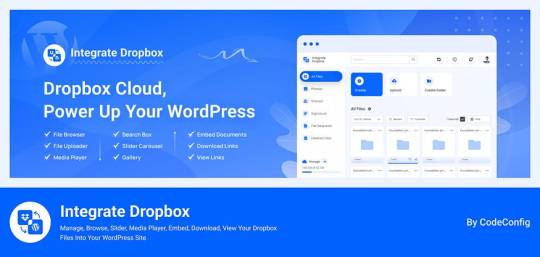
Integrate Dropbox offer smooth integration between Dropbox and WordPress with the most user-friendly Dropbox plugin from WordPress Dashboard. Easily Manage your media files and save hosting space without coding hassles. This plugin has several benefits. It allows users to access Dropbox files in the WordPress Media Library. They can also upload and download files directly from the dashboard. These files automatically sync with their Dropbox account.
Additionally, users can search for Dropbox files and folders in the dashboard. They can create shortcodes for display on the front end. This includes live search and thumbnail previews.
Price: Free for the base plugin, This plugin has Premium Plan
Features Of Integrate Dropbox
⚙️ Easy Setup — Effortlessly Setup! With this plugin, just add the Dropbox App and Secret Key from your Dropbox account to authorize Dropbox Account and WordPress integration. Documentation
🔎 Search Module — Search your Dropbox Files and Folders by name and use them in your shortcode, featured images, or different pages and posts.
🗂️ Upload/Create files & folders — Upload or Create Files and Folder in Dropbox files from your WordPress dashboard
👷♀️ Shortcode Builder — Shortcode Builder lets users easily create and customize modules. These include a Media Player, Slider, File Browsers, Galleries, and Download & Embed links. Users can insert the generated shortcode anywhere on their WordPress site.
🌆 Gallery — Gallery allows you to create a gallery to display images and videos interactively. Showcase your content beautifully and engage your audience with a visually appealing presentation.
🛠️ Shortcode Module — Shortcode Module allows you to easily select and insert built-in shortcodes from a dropdown menu, streamlining the process of adding custom features to your website.
📄 Embed Documents — Embed your Dropbox documents directly into your WordPress website.
🔗 Download Links — Allow your e-commerce, Digital Product customers to download media and document files.
👁️ View Links — Protect your important files by allowing customers to only view them without downloading them.
🛟 Preloader — Choose from our selection of predefined preloaders to enhance your website’s loading experience.
🌈 Customize Backend Colors- Easily customize the colors of your website’s backend using our predefined options.
📱 Responsive Design- The plugin makes your File Browser, Gallery, Upload Box, and Media Player look great on desktop and mobile. It provides a seamless user experience.
UpdraftPlus

UpdraftPlus is a top WordPress plugin for easy backups and restores. It allows users to store backups in Dropbox safely. The plugin excels in features. Notably, it offers automated backup schedules for easy recovery. It also supports incremental backups, saving only changes since the last full backup. This approach cuts down on space and resource use. Moreover, UpdraftPlus encrypts backups before sending them to Dropbox, ensuring added security.
Price: Free for the base plugin, This plugin has Premium Plan
WP Media Folder

WP Media Folder connects your WordPress media library to Dropbox for easy management. You can organize Dropbox media directly from WordPress. The interface is similar to desktop applications, making it simple to use. Changes made in one platform appear in the other instantly. It also allows you to create galleries from Dropbox images, improving your website’s media handling.
Price: The plugin offers a Premium Plan.
Out-of-the-Box
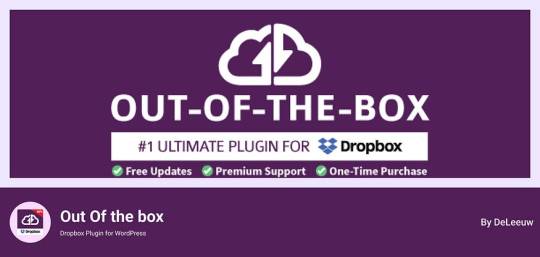
Out of the Box is a WordPress plugin that integrates Dropbox files. It brings your Dropbox info to the WordPress dashboard. You can easily drag and drop content. This is especially useful for projects with multiple users needing frequent updates. The plugin keeps files in sync, ensuring a smooth experience across both platforms.
Price: This plugin has Premium Plan
WooCommerce Dropbox
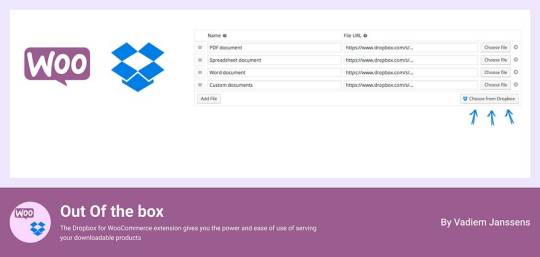
WooCommerce Dropbox lets store owners link their digital products to Dropbox files. It enhances WooCommerce and ensures timely delivery of digital products. This setup is especially helpful for selling digital items like software, music, or videos.
Shoppers get fast and simple downloads without slowing the website down. Using less server effort helps the site stay strong when many people visit. The WooCommerce Dropbox plugin improves downloadable products. It allows store owners to use Dropbox for their files. This saves server space and speeds up downloads for customers.
Price: Free for the base plugin
Dropr

Dropr links Dropbox to your WordPress site easily. It sets Dropbox as the main storage for media files. Thus, all uploads go directly to Dropbox, saving server space. Moreover, Dropr lets you share Dropbox files in your WordPress media library and embed them in posts. Uploading images, videos, or documents with Dropr is as simple as using local files.
This setup is perfect for sites with lots of posts and resources. It ensures constant updates and supports various media. Dropr speeds up file transfers. This way, you keep your site fresh and active.
Price: Free for the base plugin, This plugin has Premium Plan
Zapier

Zapier links with WordPress and Dropbox to automate tasks. Though not standard plugins, they create complex workflows, enhancing efficiency and collaboration. For example, you can automatically post on WordPress when new files are added to Dropbox. This feature is especially beneficial for teams that need an updated and efficient online dashboard.
Price: Free for the base plugin, This plugin has Premium Plan
Top Reasons to Choose Integrate Dropbox over competitors
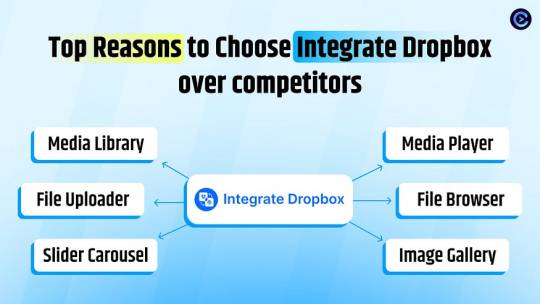
Integrate Dropbox plugin is free for WordPress and links your site to Dropbox easily. It’s perfect for organizing files. Site owners with often updated content find it especially helpful. They can manage everything from one place. This prevents issues with file syncing and access, all through the WordPress dashboard.
File Browser offers easy access to Dropbox files from any device upload on WordPress media library. Meanwhile, the Media Player lets users play Dropbox media on their WordPress site with a customizable player. By upgrading to premium, users can create unlimited shortcodes to integrate content anywhere on their site. This feature works well with popular themes.
These features collectively enhance usability, integration, and media management, making the “Integrate Dropbox” plugin a strong choice for WordPress users.
🧩 RICH INTEGRATION WITH POPULAR PLUGINS
▶️ Media Library Integration Simply use your Dropbox files from WordPress Media library and add the images in pages and posts as media, featured images, galleries, etc. Get the Image from Dropbox directly.
🔀 Gutenberg Block Editor Integration Integrate Dropbox allows 7 blocks for using File Browser, Gallery, Media Player, Slider, View, and Download link modules in the Gutenberg editor.
🔀 Elementor Website Builder Integration This plugin integrates with Elementor, offering over 7 widgets for File Browser, Gallery, Media Player, Slider, View, and Download link modules.
Conclusion
Integration of Dropbox on WordPress has turned into a necessary technique for current website scenario.
Connecting Dropbox to WordPress is now essential for managing websites. It improves file organization, backups, and collaboration. Plugins like “Integrate Dropbox” and “WP Media Folder” help site admins and developers. They can work faster and manage digital media better.
The right Dropbox WordPress plugin can greatly improve website management. It saves space and boosts performance. Additionally, it helps users create a more efficient online setup. This secures content and allows easy sharing across platforms.
6 notes
·
View notes
Text

Learn how to build a custom e-learning platform
Find out how to build a custom e-learning platform with a no-code AI driven app builder. To know more about mobile app builder, read on.
#online AI-driven app builder#no-code AI driven app builder#mobile app builder#low code AI-driven app builder
0 notes
Text
AI Books Review – Create Super Profitable Ebooks in Any Niche!
Welcome to my AI Books Review, This is a genuine user-based AI Books review where I will discuss the features, upgrades, price, demo, and bonuses how AI Books can benefit you, and my own personal opinion. This is a brand new AI-powered application that helps you create and sell super profitable eBooks, info products, eBook Covers and lead magnets in just 60 seconds.
Everyone is aware that eBooks often fetch higher prices compared to physical books, and their market growth could be significant due to the increasing adoption of eBooks among consumers. This innovative software program leverages the power of artificial intelligence (AI) to streamline the book creation process from start to finish. Whether you’re a seasoned author facing writer’s block, an entrepreneur seeking to establish brand authority, or an educator crafting captivating learning materials, AI Books promises to be your one-stop shop for efficient and high-quality book creation. We’ll also address potential drawbacks like limited creative control and originality concerns. Ultimately, this review aims to equip you with the knowledge needed to decide if AI Books is the right tool to fuel your book creation journey.

AI Books Review: What Is AI Books?
AI Books promises to be a game-changer for aspiring authors. It’s a software program that leverages artificial intelligence (AI) to streamline the book creation process. Imagine this: you input keywords or a basic outline, and the AI engine generates text for various sections of your book. This can be a massive time-saver, especially for those struggling to overcome writer’s block or facing tight deadlines.

However, AI Books is more than just a content generator. It offers a drag-and-drop editor for refining the text, a stock library for visual enhancements, and mobile optimization to ensure your book reads flawlessly on any device. This review goes into more detail about its pros and cons, as well as how it stacks up against other AI writing tools.
AI Books Review: Overview
Creator: Ned King
Product: AI Books
Date Of Launch: 2024-Jul-01
Time Of Launch: 10:00 EDT
Front-End Price: $17 (One-time payment)
Official Website: Click Here To Access
Niche: Tools And Software
Support: Effective Response
Discount: Get The Best Discount Right Here!
Recommended: Highly Recommended
Bonuses: Huge Bonuses
Skill Level Required: All Levels
Discount Code: “AIBOOKS5” To Get $5 Off Full Funnel!
Refund: YES, 30 Days Money-Back Guarantee
>> Click Here To Get AI Books Now & Limited Time Access <<
AI Books Review: Features
Create Unlimited st eBooks to in-depth long eBooks as per your marketing needs.
Loaded With 10K+ DFY Ebooks & PLR Articles.
Fully customizable Drag & Drop Ebook cover builder lets you create amazing ebook covers.
Built-in AI Content & Graphics Generator.
Fully Customizable eBook Builder lets you customize ebook templates and create your eBooks in a flash.
Add Your Branding to eBooks.
Specialized Training to Sell Your eBooks on Amazon Kindle, eBooks.com, Smashwords, Google Play Books etc.
Ready-To-Profit Automatic Account Set Up.
Add and manage unlimited chapters to your eBook.
Flipbook Creator plugin to Convert your eBooks into flip books.
Unlimited Stock Media to use in your eBooks promotion and selling.
Add Conversion Boosting Elements, Lead Magnet Inside eBook.
100% Cloud Based Software
Inbuilt Lead Capture Form for Your Website in Addition to Optin Popup.
Training & Tutorial, plus 24 Hours Support
AI Books Review: How Does It Work?
Just 3 Easy Click is All You Need to Create Engaging eBooks
Step #1:
Choose from DFY eBooks & Articles or Create one from Scratch.
Step #2:
Customize your eBook & Design eBook Cover Using Drag & Drop Editor
Step #3:
That’s it! Download your Stunning eBook and use it anywhere you want or sell it.
>> Click Here To Get AI Books Now & Limited Time Access <<
AI Books Review: Can Do For You
World’s Best AI-Based eBook Creator App
Easy Drag & Drop Fully Customizable Templates to Create eBooks in a Flash
Create and Sell eBooks in Every Possible Niche
Built-In AI-Powered Content and Graphic
Generator
No need to write content and design anything.
100% Cloud-Based Tool Hosted On Reliable Server For Seamless Usage on Any Device
No Tech Skills Required, 100% User Friendly.
Turn Any Article into an eBook with ease.
Fully Customizable eBooks Cover Builder to let you create attractive eBook Covers
Add & Manage Unlimited Chapters to your eBooks
Add Conversion Boosting Elements Inside eBooks — like CTA Button, Images, heads & footer, etc.
Free Commercial License Included
Create a Mini eBook or an in-depth long eBook as per your
need.
Full 30-Day Money Back Guarantee!
AI Books Review: Who Should Use It?
Digital Marketer
Entrepreneur
Podcaster
Affiliate Marketer
SEO Expert
Email Marketer
Coaches
Blogger
Social Media Marketer
ECom Store
Owner
Website Owner
Any Other Possible Niche
AI Books Review: OTO’s And Pricing
Add My Bundle Coupon Code “BOOKADMINMAX″ — For $30% Off Any Funnel
Front End Price: AI Books ($17)
OTO 1: AI Books Pro ($27)
OTO 2: AI Books DFY ($47)
OTO 3: AI Books Flipbooker ($47)
OTO 4: AI Books Agency ($47)
OTO 5: AI Books Reseller 100 ($47)
OTO 6: AI Books Reseller Unlimited ($67)
>> Click Here To Get AI Books Now & Limited Time Access <<
AI Books Review: My Special Unique Bonus Bundle
My Special Unique Bonus Bundle will be visible on your access page as an Affiliate Bonus Button on WarriorPlus immediately after purchase.

And before ending my honest AI Books Review, I told you that I would give you my very own unique PFTSES formula for Free.
AI Books Review: Free Bonuses
BONUS #1: Video Training on How to Publish & Sell Your eBook on Amazon Kindle
Amazon is now the biggest and most trusted online marketplace on the internet, so just having your book published on the Kindle site elicits automatic trust. Publishing your ebook to the Amazon Kindle platform is free and will give you a whole new marketplace full of targeted prospects. So, bring your ebooks into the twenty-first century by publishing them in the hottest marketplace available! And make a successful Internet business.
BONUS #2: Kindle eCover Pack
Inside this bonus package, you are about to receive 50 Kindle covers that will help you make a lot of sales online.
BONUS #3: eBook Creation & Promotion Tricks Newbies
Discover How YOU Too Can Create Your Own Collection of In-Demand, Profit-Pulling Info Products In Just Minutes From Now!
BONUS #4: How To Make Money with Kindle
Marketers that aren’t looking into Kindle are sorely missing out on one of the very best means to generate income currently available online. This is the business model that many rely on because it lets us make nearly 100% profit from all our sales.
BONUS #5: Miscellaneous Stock Photos
Inside this bonus is a bundle of high-definition photos that you can use for your own projects freely.
AI Books Review: Money Back Guarantee
And Your Investment is Risk Free with our 100% Money Back Guarantee
You may purchase with confidence because if you have a technical problem that we cannot handle, just open a ticket within 30 days and we will reimburse you everything, down to the last cent. However, we are certain that once you have AI Books, you will not ask for a refund.
>> Click Here To Get AI Books Now & Limited Time Access <<
AI Books Review: Pros and Cons
Pros:
Increased Efficiency: AI can significantly reduce writing time by generating content, outlines, and character profiles.
Overcoming Writer’s Block: Spark ideas, break creative roadblocks, and keep the content flowing even when inspiration dips.
Content Exploration: Experiment with different writing styles and explore new avenues in your writing.
Accessibility for Beginners: The user-friendly interface makes book creation approachable, even for those with limited writing experience.
Cons:
You need to be connected to the internet to use this tool.
In fact, I haven’t found any additional AI Books issues.
Frequently Asked Questions (FAQ’s)
Q. What is AI Books?
AI Books is an advanced AI-powered tool designed to assist in the creation, editing, and publishing of books across various genres, providing efficiency and quality.
Q. How does AI Books improve efficiency in book creation?
AI Books automates many aspects of the writing process, significantly reducing the time and effort required to produce high-quality content.
Q. Can AI Books be used for self-publishing?
Yes, AI Books is highly effective for self-publishing, offering tools and features that cater specifically to independent authors.
Q. What are the main limitations of AI Books?
Some limitations include issues with creative originality and difficulties in genre-specific writing, which users should consider before integrating it into their workflow.
Q. How frequently is AI Books updated?
AI Books is regularly updated with new features and advanced AI algorithms to enhance its capabilities and user experience.
AI Books Review: My Recommendation
AI Books offers a compelling solution for those seeking to expedite book creation. Its AI-powered features can significantly boost efficiency and overcome writer’s block. However, the crucial question remains: is AI-generated content a springboard to success or a shortcut to mediocrity? This review has equipped you with the knowledge to weigh the potential benefits and drawbacks. Ultimately, the decision of whether AI Books becomes your writing companion hinges on your individual needs, expectations, and commitment to crafting a truly unique and impactful book.
>> Click Here To Get AI Books Now & Limited Time Access <<
Check Out My Previous Reviews: Scalar App Review, AI Gigz Hub Review, WP Funnels Review, Gizmo Review, Auto Health Sites Review, Vocal Clone AI Review, TubeBuildr AI Review, & ClickSchedule Ai Review.
Thank for reading my AI Books Review till the end. Hope it will help you to make purchase decision perfectly.
Disclaimer:
It’s important to note that pricing and specific features of AI Books can change. While this review strives to provide accurate information, referring to the official AI Books website for the latest updates is recommended. Additionally, this review is not a substitute for your own judgment. We encourage you to explore AI Books and similar software options to determine the best fit for your book creation journey.
Note: This is a paid software, however the one-time cost is $17 for lifetime access.
#AI Books#AI Books App#AI Books Upgrades#AI Books Overview#AI Books Features#AI Books Review#AI Books Works#What Is AI Books#Buy AI Books#AI Books Price#AI Books Demo#AI Books Discount#AI Books Honest Review#AI Books Pricing#AI Books FE#AI Books Pros#AI Books OTO#AI Books Preview#AI Books Scam#Get AI Books#AI Books Reviews#Purchase AI Books#AI Books Legal#Artificial Intelligence#AI#AI Books Benefits#AI Books Bonus#AI Books Bonuses#AI Books Software#AI Books Software Review
4 notes
·
View notes